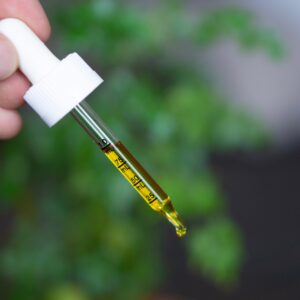 By: Ellen Lenox Smith
By: Ellen Lenox Smith
When it was first suggested I try medical marijuana to see if it would relieve the pain being experienced, I thought the doctor was nuts.
Back in 2007, I had never once even thought about that as an option. I had tried marijuana recreationally in college and hated the feeling of being out of control of my body. I was desperate, however, and had to consider this as a possibility because, at that time, I was not taking anything for help with two painful, incurable conditions. Since birth, I negatively reacted to most medications. I had gotten to the point where it was better to learn to live with the pain instead of the pain and a reaction to a medication. In time, these reactions were justified through the DNA drug sensitivity testing. (You can learn more about drug sensitivity testing through a past webinar, here.) It showed that I was not able to metabolize most medications, including all opiates and even over-the-counter drugs like aspirin and Tylenol.
Due to sarcoidosis in my chest, I had to be sure trying medical marijuana would even be safe, assuming I was to smoke to achieve relief. However, to my shock, the pulmonologist thought using it would be a great idea… as long as I never smoked. He warned smoking anything with my condition could be fatal. His opinion was that vaporizing would be safe to try, yet somehow even vaporizing concerned me.
I will not lie – I was so scared to even put this into my body with a lifetime’s worth of reactions. But, I was desperate to sleep, think more clearly, and improve the quality of my life. So, I decided to try converting the product into an oil form, to be taken before bed and activate while sleeping. At that time, with no compassion centers to purchase the product, I turned to the black market to get some to try. I ground the product and made the oil and took a chance that night to see what the results would be.
It turned out to be my answer!
That single teaspoon of oil allowed me to sleep the entire night something I had not done in years. I quickly found out that night that quality rest helps regardless of what is wrong. Most of us suffering in pain tend to not rest well and wake up to a day of struggling over and over along with increased exhaustion.
I have continued using medical cannabis since that first night in 2007. I have learned to grow my own product here in Rhode Island, where one is allowed to do so, along with taking on people I have been a caregiver for. I was so shocked by the results of a product I was so scared to try that I also quickly became an advocate. I figured if I was so scared and assumed I would just be high all the time, that others were also and did not realize the following: Those living with pain get pain relief using cannabis. The high will happen if you take more than your body needs or if you wake up in the night. Most nights I go to sleep and wake up the next morning – still living with two incurable conditions, but having had a night of excellent rest and some quality of life the next day.
I would like to share what this method of treatment means for me:
- Privacy due to being taken at night.
- Easy to travel with using a medical bottle.
- No smell – I mix a teaspoon of oil with some form of food one hour before bed and the activation begins
- Unless you are like me and open with others about using medical marijuana, this method remains private; others can’t detect it on you.
- Even if you aren’t able to grow your own, you can still purchase the product.
- When you reach the correct dose for your body, you may be lucky like me and not need to turn to medication during the day. I find what I take at night then keeps the body calm into the next day until the next night’s dose.
Things to keep in mind when beginning treatment with medical cannabis:
- You need to start with a much lower dose to introduce cannabis to your body slowly.
- If ingesting, take one hour before you want to be in bed for the night.
- The goal is to eventually sleep through the night and not wake up groggy – so each night, slowly increase the dosage until you have slept the night and not woken up in the AM groggy. If that sensation happens, don’t panic. It will wear off throughout the morning and tells you to be sure to not take the dose again but instead decrease a bit. With the right dose, you sleep and do not wake up feeling groggy.
- Ingesting is safer for your lungs than smoking.
For many achieving their true dose can mean less need for medication during the day, because it keeps the body calm into the next day. We have found that using more than one type of night indica plant creates a great sleeping oil. For breakout pain, pay attention to which type of plant you use – sativa makes a daytime relief, indica makes a nighttime relief.
May you, too, find your safe relief with pain. We all deserve a chance for a better quality of life and this just might be your answer too!
May life be kind to you.
 Ellen Lenox Smith has emerged as a leading voice for patients living with pain. Featured in local and national press accounts, Ellen brings a reasoned and compassionate perspective to the need for safe patient access to effective therapies, especially medical cannabis. Currently, Ellen serves as Co-Director of Medical Cannabis Advocacy for U.S. Pain Foundation and is a member of its Board of Directors. She also serves on the Rhode Island Patient Advocacy Coalition as secretary, was appointed by the governor to the Adaptive Telephone Equipment Loan Program, and is part of the Oversight Committee for the Compassion Centers in RI. She is active with the EDS RI support group. Prior to patient advocacy, Ellen was a longtime middle school social studies teacher. She has been married for 46 years and is the proud mother of four adult children and grandmother to five grandchildren. She also is the author of two books, an organic gardener, and was previously a master swimmer and high school swim teacher.
Ellen Lenox Smith has emerged as a leading voice for patients living with pain. Featured in local and national press accounts, Ellen brings a reasoned and compassionate perspective to the need for safe patient access to effective therapies, especially medical cannabis. Currently, Ellen serves as Co-Director of Medical Cannabis Advocacy for U.S. Pain Foundation and is a member of its Board of Directors. She also serves on the Rhode Island Patient Advocacy Coalition as secretary, was appointed by the governor to the Adaptive Telephone Equipment Loan Program, and is part of the Oversight Committee for the Compassion Centers in RI. She is active with the EDS RI support group. Prior to patient advocacy, Ellen was a longtime middle school social studies teacher. She has been married for 46 years and is the proud mother of four adult children and grandmother to five grandchildren. She also is the author of two books, an organic gardener, and was previously a master swimmer and high school swim teacher.
